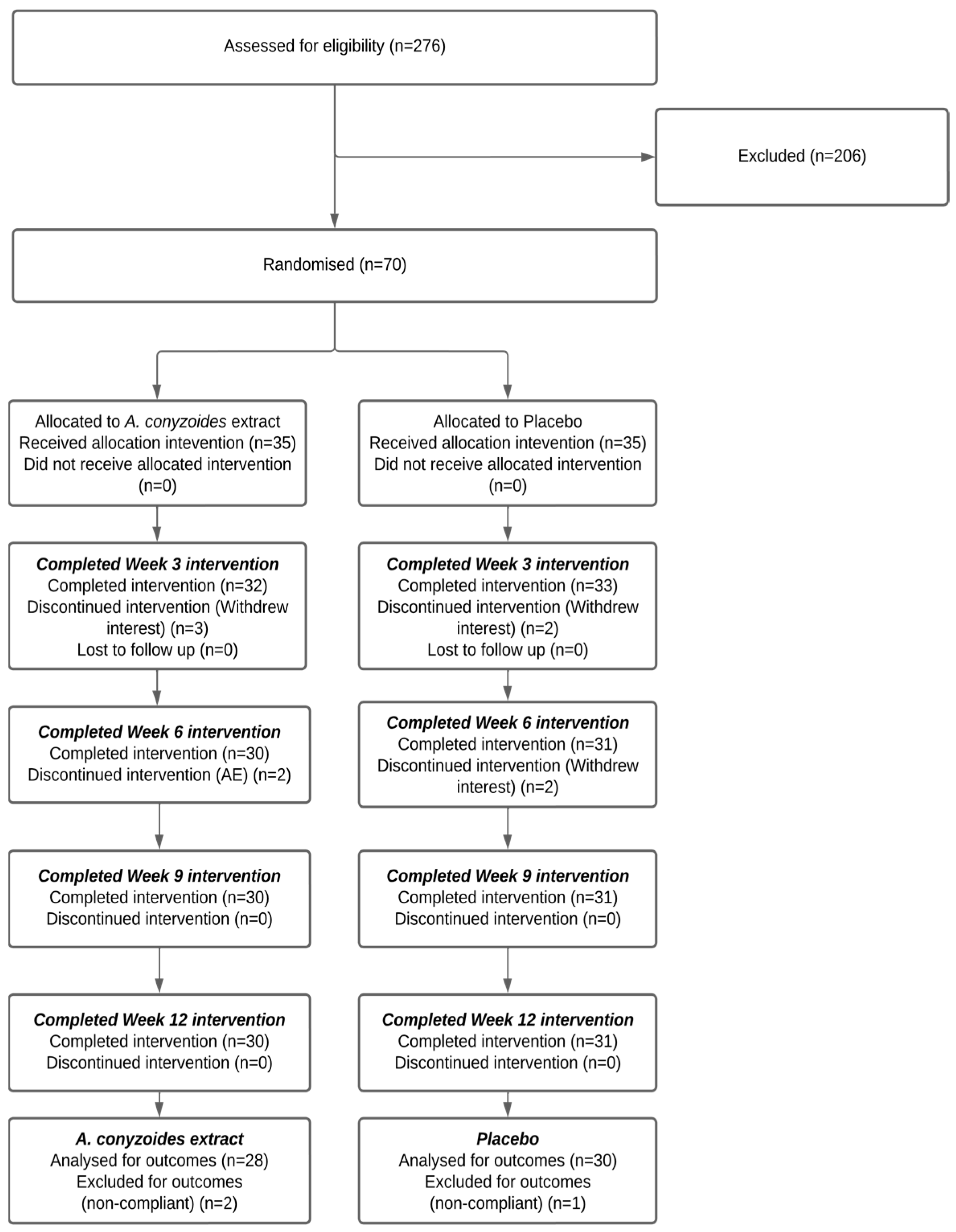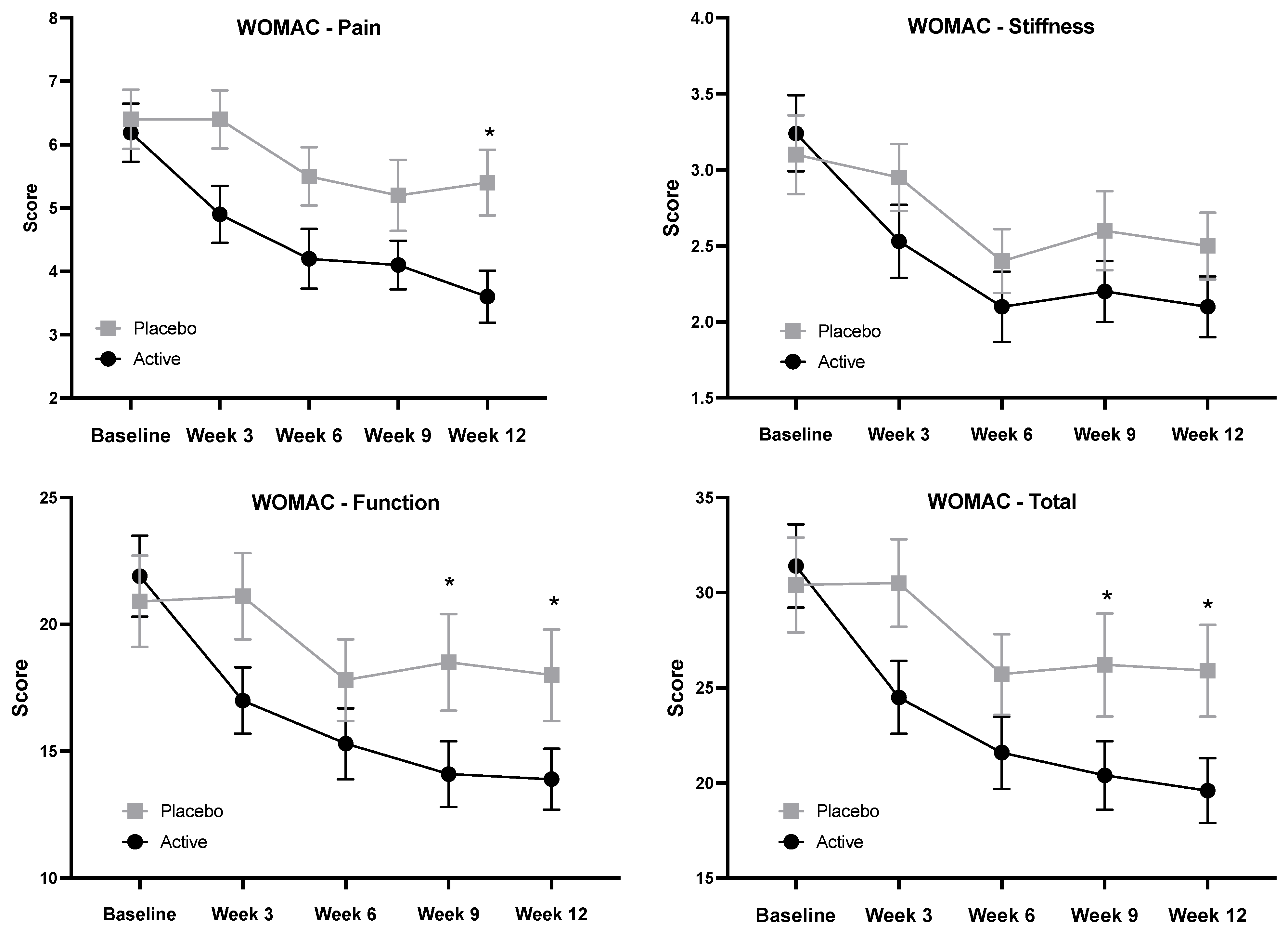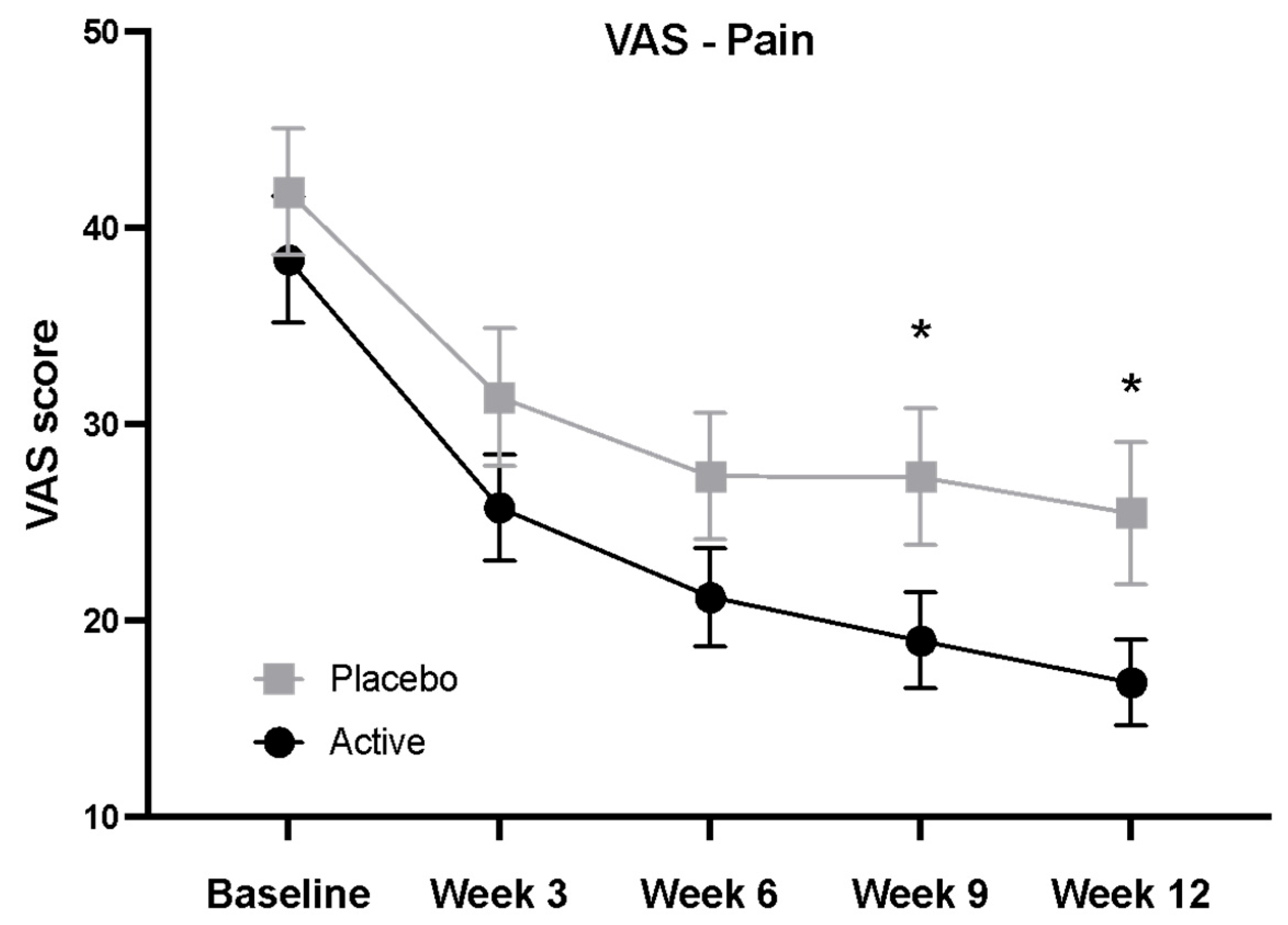Effect of Ageratum Conyzoides on Osteoarthritis in an Ageing Adult Population: A Double-Blind Randomized Placebo-Controlled Parallel Study
Abstract
1. Introduction
2. Materials and Methods
2.1. Study Design
2.2. Study Population
2.3. Chemical Analysis
2.4. Study Procedure
2.5. Outcome Measures
2.6. Statistical Analysis
2.7. Ethical Considerations
3. Results
4. Discussion
5. Conclusions
Author Contributions
Funding
Institutional Review Board Statement
Informed Consent Statement
Data Availability Statement
Conflicts of Interest
Abbreviations
| AE | Adverse Events |
| AMS | Ageing Male Symptom |
| E/LFT | Enzyme And Liver Function Test |
| IL | Interleukin |
| IPSS | International Prostate Symptom Score |
| MMPs | Matrix Metalloproteinases |
| MIA | Monosodium Iodoacetate |
| NSAIDS | Nonsteroidal Anti-Inflammatory Drugs |
| OA | Osteoarthritis |
| TNF | Tumor Necrosis Factor |
| VAS | Visual Analogue Scale |
| WOMAC | Western Ontario and McMaster Universities Osteoarthritis Index |
| WHQ | Women’s Health Questionnaire |
References
- Australian Institute of Health and Welfare. Osteoarthritis, What Is Osteoarthritis? Available online: https://www.aihw.gov.au/reports/chronic-musculoskeletal-conditions/osteoarthritis?utm_source=chatgpt.com#description (accessed on 21 August 2025).
- Chen, D.; Shen, J.; Zhao, W.; Wang, T.; Han, L.; Hamilton, J.L.; Im, H.-J. Osteoarthritis: Toward a comprehensive understanding of pathological mechanism. Bone Res. 2017, 5, 16044. [Google Scholar] [CrossRef] [PubMed]
- Grassel, S.; Muschter, D. Recent advances in the treatment of osteoarthritis. F1000Research 2020, 9, F1000 Faculty Rev-325. [Google Scholar] [CrossRef] [PubMed]
- Loeser, R.F.; Goldring, S.R.; Scanzello, C.R.; Goldring, M.B. Osteoarthritis: A disease of the joint as an organ. Arthritis Rheumatol. 2012, 64, 1697–1707. [Google Scholar] [CrossRef] [PubMed]
- Tong, L.; Yu, H.; Huang, X.; Shen, J.; Xiao, G.; Chen, L.; Wang, H.; Xing, L.; Chen, D. Current understanding of osteoarthritis pathogenesis and relevant new approaches. Bone Res. 2022, 10, 60. [Google Scholar] [CrossRef]
- Salman, L.A.; Ahmed, G.; Dakin, S.G.; Kendrick, B.; Price, A. Osteoarthritis: A narrative review of molecular approaches to disease management. Arthritis Res. Ther. 2023, 25, 27. [Google Scholar] [CrossRef]
- Molnar, V.; Matišić, V.; Kodvanj, I.; Bjelica, R.; Jeleč, Ž.; Hudetz, D.; Rod, E.; Čukelj, F.; Vrdoljak, T.; Vidović, D.; et al. Cytokines and Chemokines Involved in Osteoarthritis Pathogenesis. Int. J. Mol. Sci. 2021, 22, 9208. [Google Scholar] [CrossRef]
- Akeson, G.; Malemud, C.J. A Role for Soluble IL-6 Receptor in Osteoarthritis. J. Funct. Morphol. Kinesiol. 2017, 2, 27. [Google Scholar] [CrossRef]
- Vuolteenaho, K.; Koskinen, A.; Kukkonen, M.; Nieminen, R.; Paivarinta, U.; Moilanen, T.; Moilanen, E. Leptin enhances synthesis of proinflammatory mediators in human osteoarthritic cartilage--mediator role of NO in leptin-induced PGE2, IL-6, and IL-8 production. Mediat. Inflamm. 2009, 2009, 345838. [Google Scholar] [CrossRef]
- Hunter, D.J.; Felson, D.T. Osteoarthritis. BMJ 2006, 332, 639–642. [Google Scholar] [CrossRef]
- Fendrick, A.M.; Greenberg, B.P. A review of the benefits and risks of nonsteroidal anti-inflammatory drugs in the management of mild-to-moderate osteoarthritis. Osteopath. Med. Prim. Care 2009, 3, 1. [Google Scholar] [CrossRef]
- Wongrakpanich, S.; Wongrakpanich, A.; Melhado, K.; Rangaswami, J. A Comprehensive Review of Non-Steroidal Anti-Inflammatory Drug Use in The Elderly. Aging Dis. 2018, 9, 143–150. [Google Scholar] [CrossRef] [PubMed]
- Taylor, S.D.; Everett, S.V.; Taylor, T.N.; Watson, D.J.; Taylor-Stokes, G. A measure of treatment response: Patient and physician satisfaction with traditional NSAIDs for osteoarthritis control. Open Access Rheumatol. 2013, 5, 69–76. [Google Scholar] [CrossRef] [PubMed]
- Magni, A.; Agostoni, P.; Bonezzi, C.; Massazza, G.; Menè, P.; Savarino, V.; Fornasari, D. Management of Osteoarthritis: Expert Opinion on NSAIDs. Pain Ther. 2021, 10, 783–808. [Google Scholar] [CrossRef] [PubMed]
- Castro-Dominguez, F.; Vargas-Negrin, F.; Perez, C.; Gutierrez-Prieto, H.; Rebollo, P. Unmet Needs in the Osteoarthritis Chronic Moderate to Severe Pain Management in Spain: A Real Word Data Study. Rheumatol. Ther. 2021, 8, 1113–1127. [Google Scholar] [CrossRef]
- Okunade, A.L. Ageratum conyzoides L. (Asteraceae). Fitoterapia 2002, 73, 1–16. [Google Scholar] [CrossRef]
- Galati, E.M.; Miceli, N.; Taviano, M.F.; Sanogo, R.; Raneri, E. Anti-inflammatory and Antioxidant Activity of Ageratum conyzoides. Pharm. Biol. 2001, 39, 336–339. [Google Scholar] [CrossRef]
- Yadav, N.; Ganie, S.A.; Singh, B.; Chhillar, A.K.; Yadav, S.S. Phytochemical constituents and ethnopharmacological properties of Ageratum conyzoides L. Phytother. Res. 2019, 33, 2163–2178. [Google Scholar]
- Adebayo, H.A.; Zheng, G.Z.; Fan, J.T.; Ji, C.; He, W.J.; Xu, J.J.; Zhang, Y.M.; Akindahunsi, A.A.; Kela, R.; Tan, N.H. Biochemical, haematological and histopathological studies of extract of Ageratum conyzoides L. in Sprague Dawley rats. J. Med. Plants Res. 2010, 4, 2264–2272. [Google Scholar]
- Chahal, R.; Nanda, A.; Akkol, E.K.; Sobarzo-Sánchez, E.; Arya, A.; Kaushik, D.; Dutt, R.; Bhardwaj, R.; Rahman, M.H.; Mittal, V. Ageratum conyzoides L. and Its Secondary Metabolites in the Management of Different Fungal Pathogens. Molecules 2021, 26, 2933. [Google Scholar] [CrossRef]
- Moura, A.C.; Silva, E.L.; Fraga, M.C.; Wanderley, A.G.; Afiatpour, P.; Maia, M.B. Antiinflammatory and chronic toxicity study of the leaves of Ageratum conyzoides L. in rats. Phytomedicine 2005, 12, 138–142. [Google Scholar] [CrossRef]
- Faqueti, L.G.; Brieudes, V.; Halabalaki, M.; Skaltsounis, A.L.; Nascimento, L.F.; Barros, W.M.; Santos, A.R.; Biavatti, M.W. Antinociceptive and anti-inflammatory activities of standardized extract of polymethoxyflavones from Ageratum conyzoides. J. Ethnopharmacol. 2016, 194, 369–377. [Google Scholar] [CrossRef]
- Bahtiar, A.; Nurazizah, M.; Roselina, T.; Tambunan, A.P.; Arsianti, A. Ethanolic extracts of babandotan leaves (Ageratum conyzoides L.) prevents inflammation and proteoglycan degradation by inhibiting TNF-alpha and MMP-9 on osteoarthritis rats induced by monosodium iodoacetate. Asian Pac. J. Trop. Med. 2017, 10, 270–277. [Google Scholar] [CrossRef]
- Permawati, M.; Anwar, E.; Arsianti, A.; Bahtiar, A. Anti-inflammatory activity of nanoemulgel formulated from Ageratum conyzoides (L.) L. and Oldenlandia corymbosa L. extracts in rats. J. Nat. Remedies 2019, 19, 124–134. [Google Scholar] [CrossRef]
- Hunter, D.J.; Lo, G.H. The management of osteoarthritis: An overview and call to appropriate conservative treatment. Rheum. Dis. Clin. N. Am. 2008, 34, 689–712. [Google Scholar] [CrossRef]
- Zhang, W.; Ouyang, H.; Dass, C.R.; Xu, J. Current research on pharmacologic and regenerative therapies for osteoarthritis. Bone Res. 2016, 4, 15040. [Google Scholar] [CrossRef]
- Usher, K.M.; Zhu, S.; Mavropalias, G.; Carrino, J.A.; Zhao, J.; Xu, J. Pathological mechanisms and therapeutic outlooks for arthrofibrosis. Bone Res. 2019, 7, 9. [Google Scholar] [CrossRef]



| Characteristic | A. conyzoides (n = 28) | Placebo (n = 30) |
|---|---|---|
| Age (years) | 63.9 (8.4) | 64.8 (9.6) |
| Weight (kg) | 75.1 (14.2) | 78.7 (15.1) |
| Height (m) | 1.7 (0.1) | 1.7 (0.1) |
| BMI (kg/m2) | 26.7 (4.1) | 27.8 (4.7) |
| Waist (cm) | 90.4 (11.2) | 92.5 (12.2) |
| Hip (cm) | 104.8 (10.8) | 106.5 (10.8) |
| A. conyzoides (n = 28) | Placebo (n = 30) | |||||||||
|---|---|---|---|---|---|---|---|---|---|---|
| Baseline | Week 3 | Week 6 | Week 9 | Week 12 | Baseline | Week 3 | Week 6 | Week 9 | Week 12 | |
| Joint Pain | 6.2 (2.9) | 4.9 (2.9) | 4.2 (3.0) | 4.1 (2.4) | 3.6 (2.6) * | 6.4 (3.1) | 6.4 (3.3) | 5.5 (3.0) | 5.2 (3.7) | 5.4 (3.4) |
| Joint Stiffness | 3.2 (1.6) | 2.5 (1.5) | 2.1 (1.5) | 2.2 (1.3) | 2.1 (1.3) | 3.1 (1.7) | 3.0 (1.4) | 2.4 (1.4) | 2.6 (1.7) | 2.5 (1.4) |
| Joint Function | 21.9 (10.2) | 17.0 (8.5) | 15.3 (8.7) | 14.1 (8.6) * | 13.9 (7.6) * | 21.0 (12.1) | 21.1 (10.9) | 17.8 (10.2) | 18.5 (12.6) | 18.0 (11.5) |
| WOMAC Total | 31.4 (13.9) | 24.5 (12.1) | 21.6 (12.4) | 20.4 (11.5) * | 19.6 (10.8) * | 30.4 (16.1) | 30.5 (14.7) | 25.7 (14.1) | 26.2 (17.5) | 25.9 (15.6) |
| Time | A. conyzoides (n = 28) | Placebo (n = 30) |
|---|---|---|
| Baseline | 38.4 (17.5) | 41.9 (18.9) |
| Week 3 | 25.8 (14.8) | 31.4 (20.0) |
| Week 6 | 21.2 (13.7) | 27.4 (18.0) |
| Week 9 | 19.0 (13.3) * | 27.3 (19.3) |
| Week 12 | 16.9 (11.9) * | 25.5 (20.1) |
| Domain | A. conyzoides (n = 28) | Placebo (n = 30) | ||||
|---|---|---|---|---|---|---|
| Baseline | Week 6 | Week 12 | Baseline | Week 6 | Week 12 | |
| Physical Functioning | 53.3 (20.8) | 62.2 (22.5) | 65.2 (18.7) | 56.3 (24.4) | 62.2 (22.0) | 60.3 (22.2) |
| Role limitations (physical) | 54.2 (43.1) | 61.7 (40.3) | 84.2 (29.0) * | 64.7 (37.5) | 72.1 (36.3) | 67.6 (42.4) |
| Role limitations (emotional) | 73.3 (39.5) | 88.9 (26.7) | 88.9 (25.3) | 75.5 (37.9) | 82.4 (32.0) | 81.4 (36.0) |
| Energy/fatigue | 59.0 (17.1) | 63.7 (14.9) | 65.8 (17.1) | 58.8 (16.4) | 61.2 (15.4) | 60.1 (17.1) |
| Emotional well-being | 80.3 (12.4) | 82.7 (11.0) | 81.9 (14.2) | 77.5 (10.6) | 80.9 (10.9) | 79.3 (14.3) |
| Social functioning | 84.2 (18.0) | 87.5 (13.9) | 90.4 (13.0) | 84.9 (20.1) | 90.4 (11.5) | 87.5 (16.6) |
| Pain | 58.1 (17.9) | 70.3 (12.5) | 73.5 (13.9) * | 56.1 (16.1) | 67.1 (18.3) | 66.6 (15.1) |
| General Health | 75.7 (12.7) | 76.7 (12.0) | 76.0 (11.7) | 74.7 (14.4) | 76.2 (14.1) | 73.7 (17.7) |
| Marker | A. conyzoides (n = 28) | Placebo (n = 30) | ||
|---|---|---|---|---|
| Baseline | Change at Week 12 | Baseline | Change at Week 12 | |
| CRP (mg/L) | 3.72 (4.59) | −0.26 (6.06) | 3.84 (3.41) | 0.77 (4.13) |
| IL-10 (pg/mL) | 33.13 (56.73) | −5.39 (18.27) | 19.33 (32.64) | 0.71 (9.20) |
| IL-6 (pg/mL) | 17.84 (26.78) | −2.40 (5.47) * | 10.79 (20.14) | 0.45 (4.56) |
| IL-8 (pg/mL) | 29.78 (41.93) | −6.35 (16.37) * | 22.62 (38.83) | 1.80 (9.71) |
| TNF-α (pg/mL) | 14.29 (13.57) | 0.65 (4.93) | 11.94 (11.07) | −0.10 (3.93) |
| PSA (ng/mL) a | 2.25 (2.38) | 0.04 (0.22) | 1.22 (1.20) | 0.04 (0.36) |
Disclaimer/Publisher’s Note: The statements, opinions and data contained in all publications are solely those of the individual author(s) and contributor(s) and not of MDPI and/or the editor(s). MDPI and/or the editor(s) disclaim responsibility for any injury to people or property resulting from any ideas, methods, instructions or products referred to in the content. |
© 2025 by the authors. Licensee MDPI, Basel, Switzerland. This article is an open access article distributed under the terms and conditions of the Creative Commons Attribution (CC BY) license (https://creativecommons.org/licenses/by/4.0/).
Share and Cite
Rao, A.; Gorman, A.; Subah, S.; Muntha, S.; Bogoda, N.; Briskey, D. Effect of Ageratum Conyzoides on Osteoarthritis in an Ageing Adult Population: A Double-Blind Randomized Placebo-Controlled Parallel Study. Nutraceuticals 2025, 5, 35. https://doi.org/10.3390/nutraceuticals5040035
Rao A, Gorman A, Subah S, Muntha S, Bogoda N, Briskey D. Effect of Ageratum Conyzoides on Osteoarthritis in an Ageing Adult Population: A Double-Blind Randomized Placebo-Controlled Parallel Study. Nutraceuticals. 2025; 5(4):35. https://doi.org/10.3390/nutraceuticals5040035
Chicago/Turabian StyleRao, Amanda, Alanna Gorman, Silma Subah, Sedratul Muntha, Nathasha Bogoda, and David Briskey. 2025. "Effect of Ageratum Conyzoides on Osteoarthritis in an Ageing Adult Population: A Double-Blind Randomized Placebo-Controlled Parallel Study" Nutraceuticals 5, no. 4: 35. https://doi.org/10.3390/nutraceuticals5040035
APA StyleRao, A., Gorman, A., Subah, S., Muntha, S., Bogoda, N., & Briskey, D. (2025). Effect of Ageratum Conyzoides on Osteoarthritis in an Ageing Adult Population: A Double-Blind Randomized Placebo-Controlled Parallel Study. Nutraceuticals, 5(4), 35. https://doi.org/10.3390/nutraceuticals5040035








